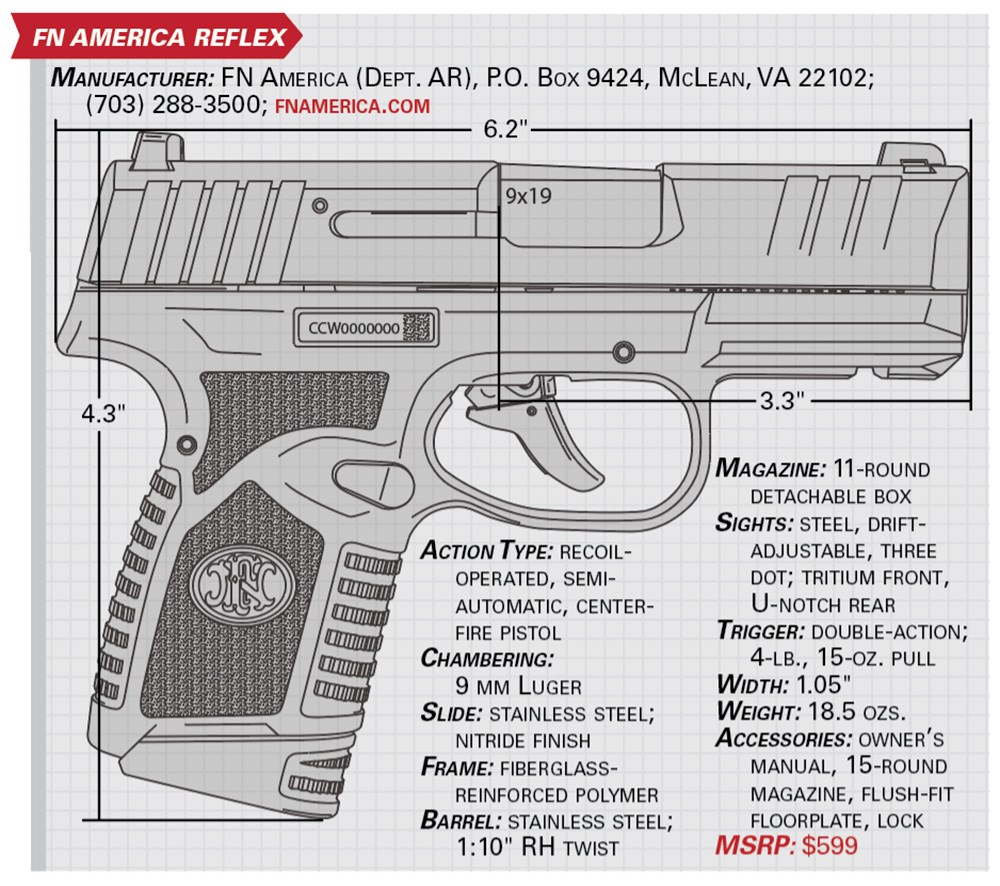
There are many firearm companies with affordably priced, broadly marketed guns that have become almost ubiquitous, thanks to their popularity within the larger firearm community. FN America is not one of those companies. That’s not to say that it produces undesirable firearms. Quite the contrary, in fact. Who doesn’t want a SCAR? The problem with FN’s guns is that they’re often priced at a point that makes them inaccessible to all but the most well-heeled of firearm enthusiasts who know what they want and aren’t afraid to shell out for it. That isn’t necessarily a bad place to be for any manufacturer, but it’s a limited market, and it misses out on the rapidly growing segment of new firearm owners.
That’s a shame, because it means FN isn’t all that well-known among much of the firearm community, especially newcomers. This year, the company is taking steps to change that, starting with one of the biggest launches in its recent history. The FN Reflex is the company’s first micro-compact handgun, and it borrows the best elements of previous FN handguns while bringing in some new features all its own. It’s also one of the most affordable centerfire handguns the company has ever offered, and that means millions of new gun owners have the opportunity to see what FN brings to the table.
While the FN Reflex is the company’s first modern micro-compact, don’t make the mistake of thinking that FN doesn’t have some experience in the concealed-carry sphere. In fact, FN has more cumulative knowledge than most companies currently playing in that market. After all, no less a man than John Moses Browning designed the first FN concealed-carry pistols. Back then, Fabrique Nationale Herstal was merely a state rifle factory with aspirations toward commercial greatness, and with the Browning mind behind the company, carry-ready designs began to proliferate. Following the inaugural Model 1900 was the Model 1903, then the Model 1905 Vest Pocket, then the Model 1910 and the product-improved M1922.
The Baby Browning was yet another miniscule marvel, and this compact carry gun was produced by FN from its inception in 1931 until the early 1970s, save for an understandable slowdown between 1940 and 1945. In fact, an FN-licensed copy continues to be produced today by Precision Small Arms. The Gun Control Act of 1968 marked the end of the line for the importation of diminutive micro pistols, though, and FN shifted its focus toward producing duty-size handguns, notably the High Power. Recently, FN America, the stateside subsidiary created through the combination of FN Manufacturing and FNH USA in 2014, had developed compact, carry-ready models as offshoots of its duty-ready designs, but the company had not developed a dedicated concealed-carry gun that kept pace with current market trends. The introduction of the FN 503 single-stack concealed-carry gun well into the development period of higher-capacity micro-compacts highlighted the company’s lag on the commercial side. Now, the Reflex promises to get FN up to speed in the concealed-carry marketplace.
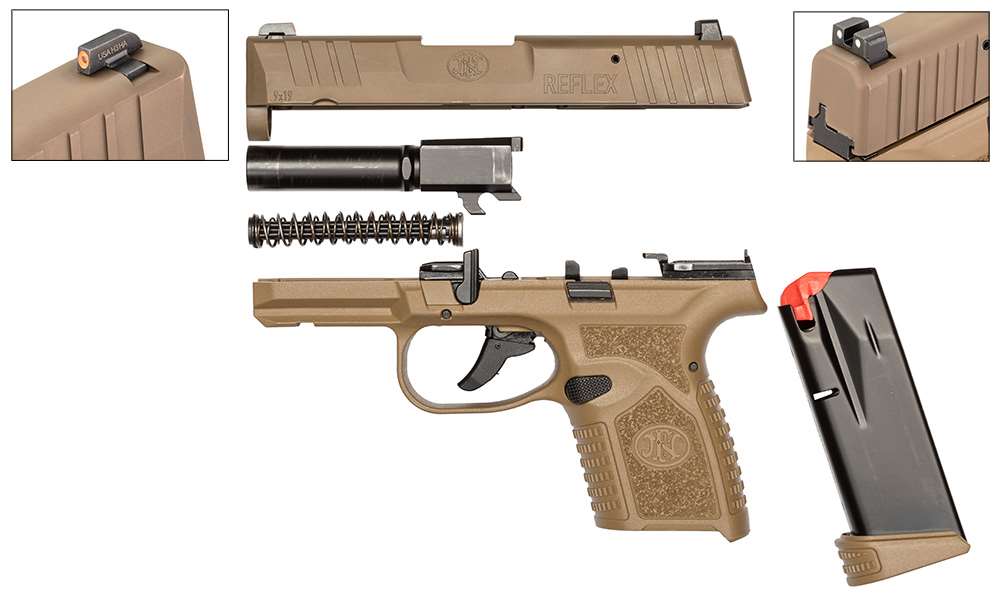
At first glance, the Reflex is recognizable as an FN design, as it borrows all the styling cues and ergonomics from the company’s class of larger FN 509-based handguns. In fact, without any size reference, one might make the mistake of thinking this is merely a compact version of a double-stack handgun FN already produces, but the Reflex borrows only ergonomics and textures from its larger brethren. Inside and out, the gun is an entirely different animal, and that makes it an attractive offering in the micro-compact marketplace. Of course, it has to make itself stand out in some way, because the concealed-carry market is thoroughly saturated with every kind of possible offering, including an incredible proliferation of micro-compact handguns. How does a new option stand out? For one, FN is bringing all of its weight in terms of quality of manufacture and military testing to bear on this new design.
“It’s probably one of the most durable handguns we’ve ever produced,” said Bob Meinert, director of marketing for FN America. “Overall, we observed a 0.002 percent failure rate in our durability testing.”
That’s quite a statement from a company that was a serious contender in the Modular Handgun Systems trials of the late 2010s. Famously, FN claimed it had put its 509 through “a million rounds” of reliability, ammunition compatibility and durability testing. That was for a military gun, though, which is understandable, considering the rigors to which a martial sidearm might be subjected. A concealed-carry gun is another matter entirely. So, let’s look at exactly what FN’s produced.
The Reflex is a polymer-frame, short-recoil-operated, semi-automatic handgun, but unlike so many options on the market, it’s actually fired by an internal hammer rather than a striker. The reason for this departure, according to FN, was to help produce a better trigger pull and to also reduce the force required to rack the slide. Many striker-fired guns, like FN’s 509 series, tend to have some level of pre-ignition force built into the striker spring, though not enough stored energy to set off a primer. The remaining energy is provided when the user pulls the trigger, which draws the striker back to its full cocking force. It’s a very safe and effective operating system, but because of that added spring tension, those who rack a striker-fired gun are fighting not only the recoil spring but also the striker spring, too. In a hammer-fired gun like the FN Reflex, overcoming the internal hammer takes much less force, and that makes the gun easier to rack. Stiff slides are a common complaint among owners of micro-compact pistols, and FN’s design will make the gun a bit more friendly to those who struggle in this department.
Starting at the top of the gun, there’s already a notable improvement over pre-existing FN designs. Instead of using the company’s system of adapter plates, the Reflex features a milled section of slide that fits all micro red-dots (MRDs) of the Shield RMSc footprint, allowing for a direct mount and eliminating any additional points of failure. With the Shield sight installed, users can easily co-witness the existing iron sights with the mounted dot, providing an easily accessible back-up in the case of battery or electronic failure, though the battery life and quality of many of today’s carry-ready MRDs makes this an unlikely scenario. A cover plate is provided for those who prefer to run the irons alone. Speaking of the sights, as befitting a concealed-carry gun, FN tops its Reflex with a decent set of steel sights that fit into corresponding dovetails in the slide, which are of the same pattern as FN’s 503 and larger 509 series.

The front sight is easily visible in low light, thanks to a tritium lamp that’s surrounded by a large, bright-orange ring that draws the eye in, even during bright daylight. The rear is a U-notch design that provides some generous space on either side of the front post. The rear face of the rear sight features two white dots that serve as reference points for aligning the front post. The front face of the rear sight is flat, continuing a trend in today’s handguns of providing a surface that can allow a firearm to be racked, one-handed, off a flat edge. One notable point regarding FN’s rear sight is that, unlike many others, this one has been thoughtfully dehorned on its leading edges to reduce the chance of a user tearing up his or her hand when grasping the slide to rack the gun into battery.
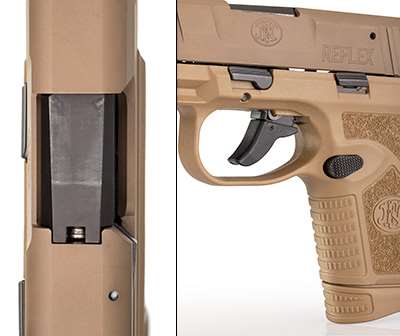
Where the beveled and tapered barrel hood meets the breechface, there’s a generous cutout at the top that allows users to look into the chamber to see whether or not the gun is loaded. The Reflex is also outfitted with an external extractor that protrudes slightly when it engages the rim of a cartridge, and that can provide a tactile reference point as to the gun’s status. The front edges of the slide at the muzzle are beveled, providing a narrower profile that makes it easier to insert the muzzle into a holster mouth. Three grooves are milled into either side at the front portion of the slide, in addition to five grooves at the rear of the slide, providing plenty of contact points for easy manipulation.
Moving down to the frame, the front of the dustcover is similarly beveled to match the profile of the slide as a holstering expedient, and there’s a single-slot accessory rail to accommodate lights and lasers. The frame flares out a bit to the rear of the accessory slot, above the trigger guard, which provides a bit of meat into which the single-sided controls can be recessed, and on the right side for right-handed shooters, also provides a touch point for an index finger when removing it from the trigger and out of the trigger guard. It’s also the widest portion of the gun, measuring in at 1.047".
At the forward portion of this section, on the left side of the gun, is the takedown lever. Located about an inch behind it is the low-profile slide-stop lever. With the slide locked to the rear, simply turn the lever 90 degrees clockwise so that its end is pointing up, release the slide-stop lever and gently allow the slide to move forward off the frame—no trigger pull required. Completing fieldstripping simply requires removing the recoil spring assembly, then the barrel. Re-assembly is completed by reversing the steps.
Of a single-sided design like the two aforementioned controls, the push-button magazine release is a textured metal component that sits in a shallow depression on the left side of the grip frame and is easily accessed with the shooting-hand thumb; the release is reversible for left-handed shooters. The magazines themselves are of a typical configuration for today’s crop of micro-compacts, one being a flush-fit, 11-round option and the other being a 15-round extended box. The pistol ships with a slightly extended floorplate on the 11-round magazine to accommodate the strong hand’s pinky, but a separate, flush-fit baseplate is included that can be installed for greater concealability. Both of the steel-bodied magazines include witness holes on their rear face for each round loaded.
The last control is, of course, the trigger itself, which incorporates a hinged safety design rather than the blade safety commonly seen on other pistols. Unlike other hinged-trigger designs of the past, the hinge point on FN’s design is much higher up, with the pivot point occurring just below the frame at the top of the trigger guard. When shooters start the trigger press, they’re working against spring tension before fully engaging the body of the trigger. This spring tension is designed to provide resistance against inertial forces in the event that the pistol is dropped and impacts on the back of the slide or backstrap, as without it, the trigger assembly and trigger bar will want to continue moving rearward and could conceivably disengage the sear and cause the gun to fire.
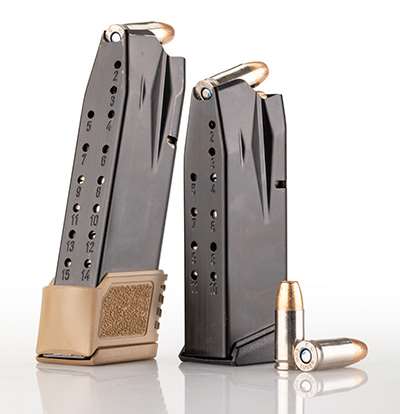
Overcoming this spring tension takes minimal effort and doesn’t contribute to much “mushiness” within the pull. On my production sample of the FN Reflex, though, I found the pull to be somewhat spongy after overcoming this hinged safety. When the trigger breaks, though, it does so quite crisply and only with a moderate amount of overtravel. However, resetting the trigger involves some distance, requiring the user to release the trigger almost all the way forward. This is the unfortunate side effect of the Reflex’s hammer-fired operating system.
At an FN media event hosted by XCAL in Ashburn, Va., we expended quite a few rounds through pre-production models of the Reflex, working through concealed-carry drills using FN’s supplied and self-produced AIWB holster. From the start, I found myself shooting tight, five-shot groups easily, and even after moving to rapid draw-and-fire drills, I consistently placed rounds center-mass quickly and without difficulty. The trigger break on the provided pre-production sample was noticeably more crisp than that of the production example fired for accuracy testing. Despite that, it clearly didn’t impact anything in the way of accuracy potential, as the production FN Reflex used for the accuracy results turned out some of the tightest groups American Rifleman has yet seen from one of these so-called micro-compact pistols.
Typically, when firing small handguns, extended range sessions aren’t a pleasant experience, because there’s no escaping the laws of physics. A smaller handgun firing a relatively powerful cartridge will be felt. Despite this truth, though, the experience with the Reflex toward the end of multiple range sessions was different. Typically, with micro-compacts, what’s felt is some soreness at the web of the hand between the thumb and index finger—the point where the recoil force from the backstrap impacts the hand. However, I felt nothing at that particular point. Where I felt it was in the palm of my hand, where the grip texturing had done its work in anchoring the pistol during firing. Those who are particularly sensitive to aggressive grip textures may not feel comfortable at the end of an extended range session with the Reflex, but there’s no question that the company’s unique, multi-aspect grip texture does the job in keeping users in control of the gun.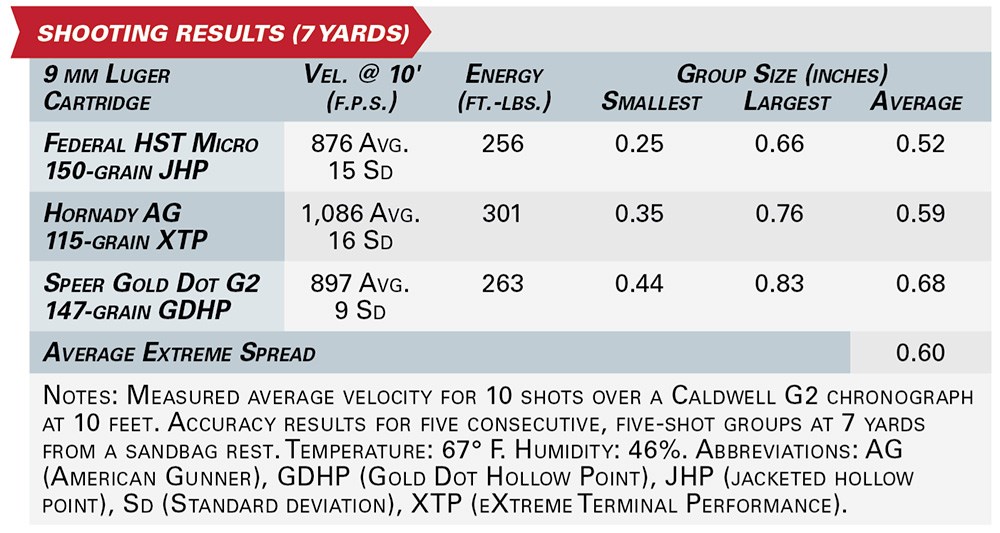
On the range and in the test bay, the Reflex proved its capability as a defensive arm, as no malfunctions were encountered through the entirety of testing. But, as evidenced by the company’s proven lineup of handguns and rifles going back decades, there’s no question that FN America can build a good firearm. Until now, the question was, “Can FN build a gun at a price point that makes it more accessible to the larger firearm community?” It’s a reasonable question, because typically, it doesn’t work out well when companies search for ways to go “cheaper.” The FN Reflex doesn’t feel cheap. It certainly doesn’t shoot like a cheap gun, and really, it’s not a cheap gun. It’s priced right around the rest of the pack in this micro-compact market. But it’s a gun with a lot of experience, knowledge and history built into it. As evidenced by its reliability and performance in our testing, there’s a lot of quality in this pistol. Given that it won’t cost you any more than its competitors, that’s a real achievement. FN’s learned from its experience in both the commercial and military markets over the past few years, it seems, and armed citizens are benefiting from these lessons.